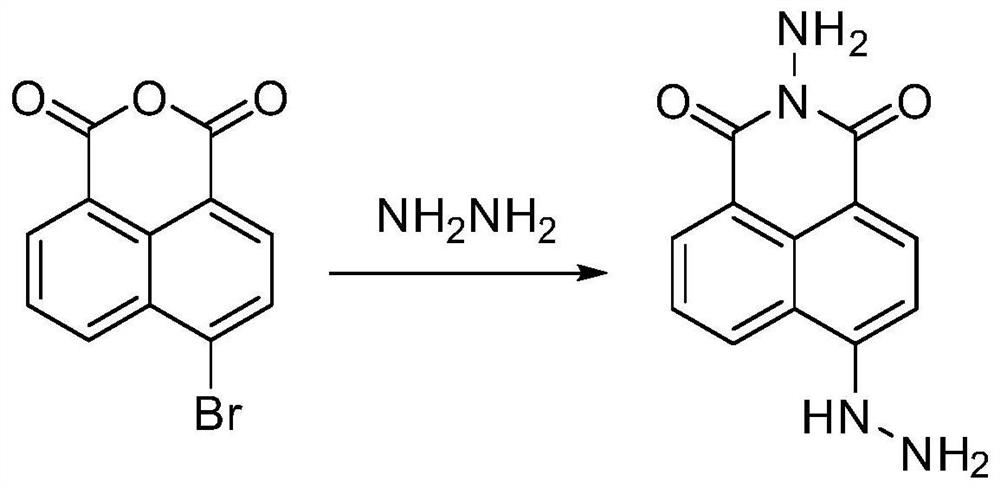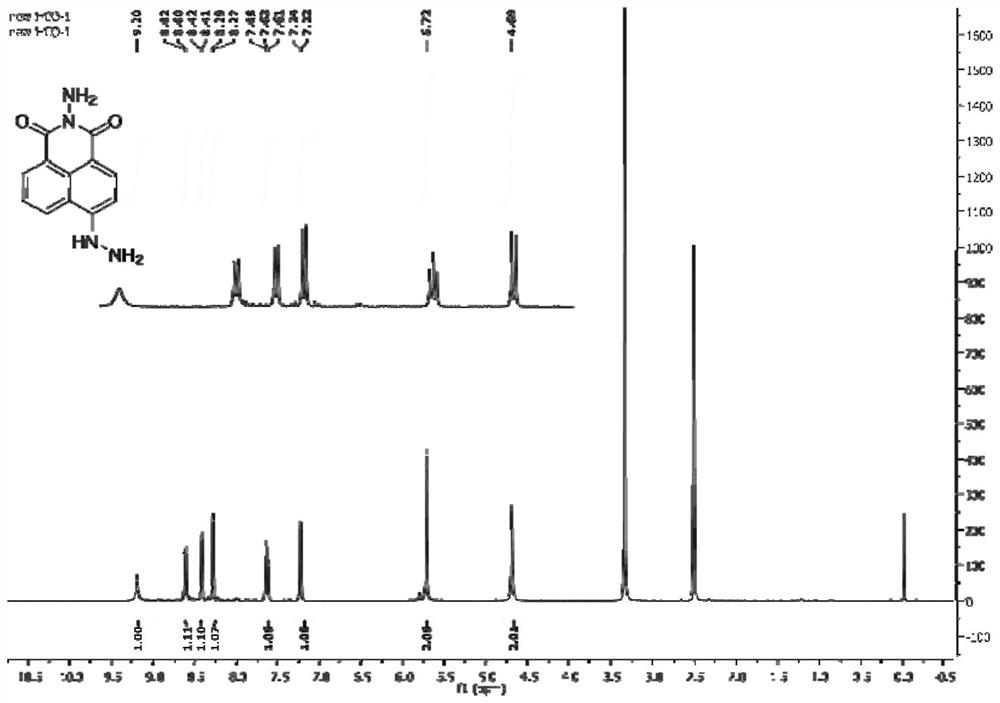Lighting type fluorescent probe for formaldehyde detection
A fluorescent and formaldehyde-based technology, applied in the field of light-up fluorescent probes for formaldehyde detection, can solve the problems of insufficient sensitivity, expensive technology, and training for formaldehyde
- Summary
- Abstract
- Description
- Claims
- Application Information
AI Technical Summary
Problems solved by technology
Method used
Image
Examples
Embodiment 1
[0033] Embodiment 1 - gas phase fluorescence detection of amines:
[0034] In this application, we synthesized amino-modified 1,8-naphthalene anhydride derivatives ( figure 1 ), and use 1 H NMR and HRMS were characterized (Fig. 2). The compound 2-amino-6-hydrazino-1H-benzisoquinoline-1,3(2H)-dione (AHB) is non-emissive in solid or solution state due to photoinduced electron transfer ( The photo-induced electron transfer (PET) effect can suppress the radiative attenuation by transferring electrons from donor orbitals to acceptor orbitals. However, the reaction of AHB with formaldehyde is able to hinder the PET process, so upon exposure to FA, the AHB molecule is “turned on” and thus enhances the emission intensity ( image 3 ). The optical properties and absorption and emission spectra of AHB were investigated and recorded in dimethylformamide (DMF) at room temperature. The absorption spectrum of pure AHB in DMF shows two peaks at 330nm and 450nm, after adding FA (200μM)...
Embodiment 2
[0035] Example 2 - Fluorescent detection of formaldehyde in the gas phase:
[0036] In solid support, AHB had no fluorescence emission initially, but a fluorescence response at 520 nm was observed after exposure to formaldehyde gas. The fast response property of AHB to formaldehyde gas makes it suitable for the fabrication of portable sensors for detection of aldehyde compounds. A portable sensor was prepared by dropping a drop of DMF solution containing 100 μM AHB onto a filter paper strip. The sensor is ready for use after the DMF has evaporated. The detection sensitivity of the AHB sensor was tested by exposure to formaldehyde vapor in a 1 M formaldehyde solution. Place 0.5 mL of 1M formaldehyde solution in a 20 mL bottle and monitor it for 180 seconds ( Figure 4 with Figure 5 ). The formaldehyde sensor was exposed to formaldehyde vapor in 1M formaldehyde solution for 60 seconds and observed fluorescence emission ( Figure 5 C). Water and air were used as controls ...
Embodiment 3
[0037] Example 3 - Fluorescence detection of formaldehyde in DMF phase:
[0038] The selectivity of AHB to formaldehyde was further verified by adding other aldehyde-containing compounds such as acetic acid, veratraldehyde, heptanal, butyraldehyde, glutaraldehyde, acetophenone, and benzaldehyde. The fluorescence intensity changed the most when formaldehyde was added, and it was also found that glutaraldehyde and acetic acid also showed obvious fluorescence response turn-on phenomenon. Other species such as veratraldehyde, heptanal, butyraldehyde, acetophenone, and benzaldehyde showed weaker changes in fluorescence intensity. Such as Image 6 As shown, under the excitation of 365nm ultraviolet light, AHB has almost no detectable fluorescence emission at 520nm. With the gradual addition of different concentrations of formaldehyde, the fluorescence emission at 520nm was gradually enhanced. By plotting the fluorescence intensity versus formaldehyde concentration, a good linea...
PUM
 Login to View More
Login to View More Abstract
Description
Claims
Application Information
 Login to View More
Login to View More - R&D
- Intellectual Property
- Life Sciences
- Materials
- Tech Scout
- Unparalleled Data Quality
- Higher Quality Content
- 60% Fewer Hallucinations
Browse by: Latest US Patents, China's latest patents, Technical Efficacy Thesaurus, Application Domain, Technology Topic, Popular Technical Reports.
© 2025 PatSnap. All rights reserved.Legal|Privacy policy|Modern Slavery Act Transparency Statement|Sitemap|About US| Contact US: help@patsnap.com



